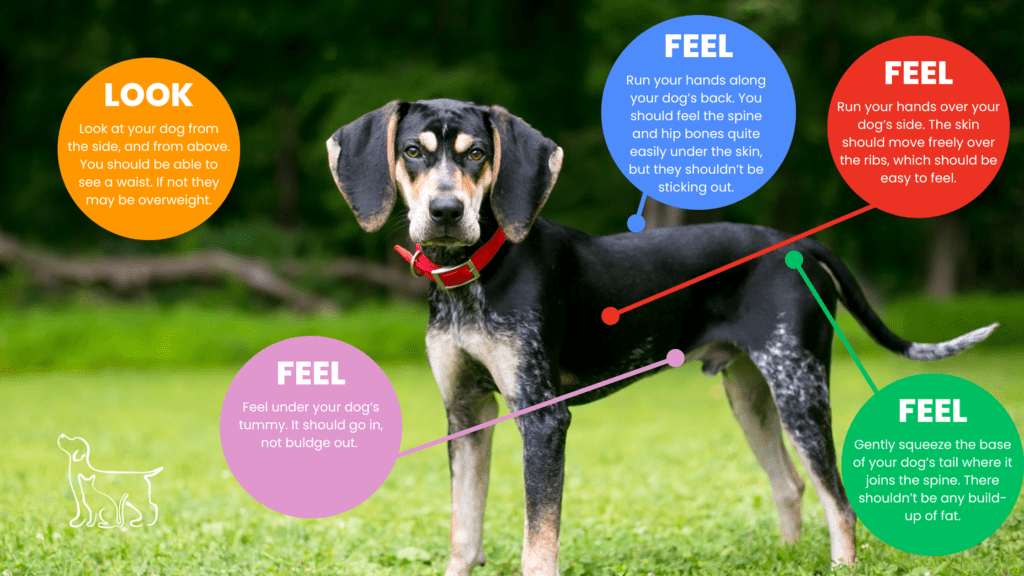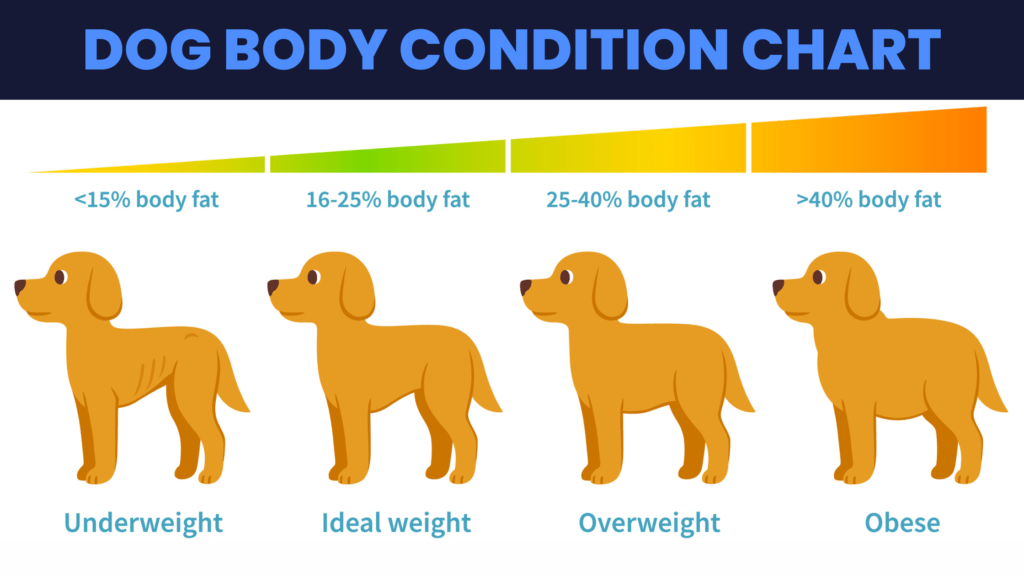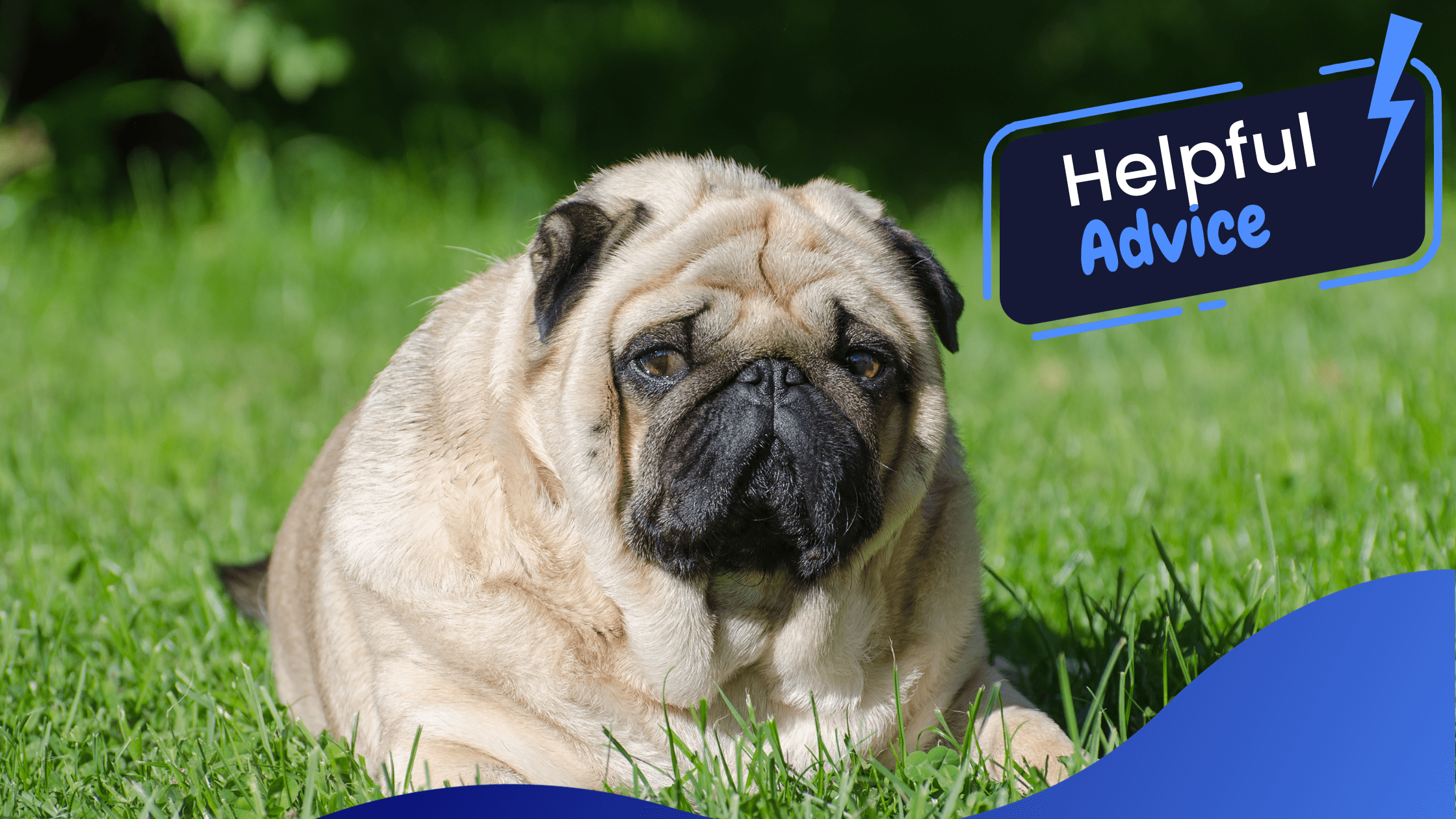Vets estimate that 50% of dogs in the UK are overweight or obese. Being obese puts your pets at risk of health problems, and is likely to reduce how long they live.
Obesity occurs when your pet has too much body fat and this negatively affects their health, well-being, and quality of life. We believe that obesity is a serious welfare issue in pets, as it can cause extreme suffering and disability. It can also affect your pet’s ability to perform normal activities, such as exercising.
Is my Dog overweight?
The best way to assess your dog is to look at their shape, their weight may fluctuate throughout life, but their ideal shape stays the same.

Look at your dog’s waistline
- Look down at your dog from directly above and from the side while he or she is standing. They should have a smooth, tucked-in waist If you can’t see their waist or their sides are bulging, your cat is probably overweight.
Feel for your dog’s ribs
- Feel along your dog’s side and back. You should be able to feel your dog’s ribs, spine, and hipbones quite easily but they shouldn’t stick out.
Feel your dog’s tummy
- Feel under your dog’s tummy. It should go in, not bulge out.
Feel the base of your dog’s tail
- Feel the base of your dog’s tail. There shouldn’t be any build-up of fat where the tail meets your dog’s back.
How To Know How Your Dog Is Overweight?
- Owners struggling to see or feel their dog’s ribs, spine, or waistline
- Abdominal sagging
- A bigger, rounder face
- A reluctance to go for walks or lagging behind
- Excessive panting
- Lack of grooming
- Difficulty breathing
- Tiredness
- Needing help getting in and out of cars
- A refusal to move or play games
Dog Obesity Chart

The Dangers Of Fat
Fat tissue was thought to be merely an energy store and a relatively lifeless insulator; but we now know that it secretes hormones that influence appetite, inflammation, insulin sensitivity, and bodily functions, as well as fluid balance and blood pressure, leading to kidney and blood disease. high pressure.
Why Is My Dog Overweight?
Excess energy is stored primarily as fat, but many other factors also contribute to obesity in dogs, including age, gender, reproductive status, inactivity, and dog decision: owner about their dog’s food intake, diet and appetite, environment, lifestyle, and any underlying diseases that impair exercise capacity and results. In case of excessive weight gain. Certain dog breeds appear to have higher rates of obesity, suggesting that genetics may play an important role, with unneutered adult dogs often weighing less than the same neutered dogs of the same breed.
NEUTERING
Neutering is usually done at a young age, coinciding with the natural decline in growth and energy requirements. Oestrogen also slows fat production, and levels predictably decrease after neutering. Therefore, owners who are unaware of this change and continue to feed their pets the same amount of food will usually notice their dogs gaining weight.
AGE
Aging dogs become less active and need less daily energy, therefore is food intake is not decreased proportionately they can easily pile masses of weight on.
LEFTOVERS
Feeding leftovers and other fatty treats can cause many pets to overeat and gain excess weight. Some adult dogs, especially toy breeds, get up to half of their calories from human food.
NOT MEASURING FOOD
Some owners are still unsure of how much to feed their dogs, as they don’t measure the amount of food accurately. The size of the cup you use to measure the dry food and the size of the bowl you use for feeding will also affect the amount of food you give your dog. Giving owners a large cup or bowl will often provide more nutrition than using a small cup or bowl.
EATING WITH OTHER DOGS
The social environment of eating can also influence eating behavior, with most dogs increasing their food intake when eating with other pets. This is called “social facilitation.” However, living as an “only dog” is also associated with a risk of obesity, which is likely caused by being pampered by the owner.
What Are The Health Risks?
Overweight pets are at increased risk of anesthesia and surgical complications, heat and exercise intolerance, complications from cardiovascular disease, hormonal problems, skin diseases, cancer, genitourinary disorders, and even premature death. , veterinarians see these problems frequently. Obesity in dogs can also cause tracheal collapse and laryngeal paralysis.
To summarise health risks
- A reduced lifespan
- Arthritis
- Urine incontinence
- Back problems
- Cruciate ligament problems
- Breathing problems
- Breathing problems in flat-faced breeds
- Heatstroke
- Injury
Preventing Obesity In Dogs
Research
If you choose a dog that doesn’t suit your lifestyle, you may experience weight or behavioral issues. It’s easy to be fooled by the appearance of a dog breed, but finding the right dog for you and your family is actually much more important.
- If you’re an active person, a dog that needs lots of exercise will be fine.
- If you are less active and would struggle to give them the exercise they need, a lower-energy dog would suit you.
Exercise
Regular exercise is essential for all dogs – it helps keep them in shape and is really important for their mental health.
The amount of daily exercise depends on their breed, age, health, fitness, and personality:
- Breed – Your dog’s breed plays a large part in their natural energy levels. Some need 1-2 hours of exercise per day, others need more than 2 hours, and some – mostly working breeds – need significantly more, plus mental stimulation throughout the day.
- Age – While your dog is growing, it’s important to protect their joints by introducing them to exercise gradually. As an adult, it is vital to ensure they stay fit and active, but as they become more senior you may notice they need a little less exercise than usual.
- Health Problems – If your dog is sick or injured, they won’t need as much exercise as usual. Rest is an important part of recovery. Give your dog as much rest as your veterinarian recommends, and keep him entertained in other ways so he doesn’t get bored or irritable.
- Fitness – If you want your dog to start doing more, or join you in a new hobby such as running or cycling, you’ll need to increase their fitness gradually to help avoid any injury or illness.
Diet
In general, a diet high in protein and fiber and low in fat is recommended for weight loss, as it gives your dog more energy while feeling full. Replacing traditional snacks with carrot sticks is a great healthy start. Make sure everyone in your family has their own instructions for feeding your pet and don’t leave food lying around.

Costs
Overweight dogs tend to cost more because they are much more likely to develop health problems than well-trained dogs. Make sure your dog is the right weight to keep veterinary costs as low as possible.
Consider purchasing insurance as soon as you get your dog before any signs of illness appear. This will ensure that you receive the support you need to care for your child throughout his or her life.
With the right diet, exercise, and behaviours, you’ll be able to protect your dog from the risks of being overweight or obese.
Thank You for reading, until next time…

